
Converting from a Keto diet to a balanced one might feel overwhelming, but it's all about adding carbs slowly. Start by introducing complex carbs like whole grains and legumes, upping your intake gradually over weeks. Keep an eye on how your body responds—some initial water weight gain is normal! Watch for cravings; it means you might need more protein or a different carb source. Aim for around 100-150 grams of carbs daily, adjusting based on activity. Remember to focus on whole foods and avoid sugary snacks. Ready to dive deeper into this tasty change?
Key Takeaways
- Gradually increase carbohydrate intake by 10% over 14 days, focusing on complex carbs like whole grains and legumes.
- Monitor body responses, tracking changes in weight, energy levels, and digestion while reintroducing carbs.
- Practice portion control by gradually increasing carbohydrate portions to manage cravings and sustain energy.
- Incorporate nutrient-dense sources like quinoa, lentils, and sweet potatoes to ease the transition.
- Avoid simple carbohydrates and processed foods, opting for whole foods to maintain stable blood sugar levels.
Understanding the Keto Diet
The Keto diet is a high-fat, very-low-carb eating plan that typically limits carbohydrate intake to around 20-25 grams of net carbs per day, translating to approximately 50 grams of total carbs. This diet is all about getting your body into a state called ketosis. When you're in ketosis, your body doesn't burn glucose (sugar) for energy anymore; instead, it burns fat. This can lead to weight loss, and that's one of the big keto benefits people talk about.
But let's bust some keto misconceptions. Some folks think the Keto diet is just about eating bacon and cheese all day. While those foods can fit into the diet, it's not that simple. You need to focus on getting enough essential nutrients too, which can be tricky.
That's why some people mix it up with high-fat/moderate-protein or high-protein/low-fat versions to suit their needs.
It's super important to remember: the Keto diet isn't meant to be a forever thing. Experts usually recommend sticking to it for about six months. After that, you should think about how to get back to a more balanced diet to avoid any nutrient deficiencies and keep your body happy and healthy.
Gradual Carbohydrate Reintroduction
Shifting from the Keto diet to a balanced diet requires careful planning, particularly when reintroducing carbohydrates. Gradually adding carbs over 14 days can help your body adjust without major weight gain or discomfort.
Start by increasing your daily carbohydrate intake by about 10%, paying close attention to your serving sizes to avoid sudden blood sugar spikes.
Here's a simple plan to follow:
- Daily Increase: Boost your carb intake by 10% each day.
- Complex Carbs: Focus on two additional servings of complex carbohydrates like whole grains and legumes.
- Carb Cycling: Alternate between higher and lower carb days to help your body adapt.
- Meal Timing: Distribute your carb intake evenly throughout the day to maintain energy levels and avoid crashes.
Incorporating complex carbohydrates will help you stay full and prevent stomach issues.
However, don't be alarmed if you gain some water weight initially; it's just your body storing glycogen, which is totally normal.
Using carb cycling and strategic meal timing can make this change smoother.
Monitoring Body Responses
Monitoring how your body reacts during the shift from keto to a balanced diet is super important.
Keep an eye on changes in your weight, energy levels, and digestion as you slowly add more carbs.
Tracking Carb Reintroduction
As you begin to reintroduce carbohydrates into your diet after following a keto regimen, it is essential to proceed gradually and methodically to monitor your body's responses accurately. Carb tracking is vital during this adjustment period. Start by increasing your carb intake by just 10 grams per day. This gradual approach helps your body adjust without causing gastrointestinal distress or weight gain.
To make this process smoother, keep a detailed food diary. Note down your daily carb intake, any weight changes, and your overall well-being. This will help you identify patterns and make informed adjustments. For example, if you notice changes in energy levels, mood, or digestion, these could be indicators of how your body is responding to the additional carbs.
Here are four key points to take into account:
- Increase carbs slowly: Add just 10 grams per day to avoid shocking your system.
- Monitor responses: Pay attention to changes in energy, mood, and digestion.
- Use a food diary: Track your carb intake, weight, and overall wellbeing.
- Watch for cravings: If cravings spike, your carb intake might be too high, or you may need more protein and healthy fats.
Aim to find a personalized carb range that aligns with your activity level and weight goals, usually around 100-150 grams per day.
Adjusting Portion Sizes
When shifting from a keto diet to a balanced diet, adjusting portion sizes of carbohydrates is essential for maintaining overall well-being and avoiding digestive discomfort. Start by gradually increasing your carbohydrate portions by about 10% each day. This way, you can enjoy more whole, nutrient-dense foods without overwhelming your system.
Remember, portion control is key to managing cravings and maintaining energy levels.
Monitoring your body's response is vital during this shift. Pay attention to any weight changes, your energy throughout the day, and any digestive issues you might experience. These signs will help you figure out if you need to adjust your portions more or less.
Aim to create balanced meals with healthy fats, lean proteins, and complex carbs that suit your energy needs and activity levels.
Using measuring tools or a food scale can help you accurately gauge portion sizes and avoid overeating. This may seem tedious, but it's an excellent way to practice mindful eating.
Listen to your hunger and fullness cues—let your body guide you rather than sticking to strict serving sizes. This mindful approach will help you transition smoothly and enjoy your meals more.
Choosing Complex Carbohydrates
Shifting back to a balanced diet means embracing complex carbohydrates, which are packed with nutrients and fiber.
Foods like quinoa, brown rice, lentils, and a variety of vegetables will keep you full and your blood sugar stable.
Start slow by adding one serving a day and gradually build up to the recommended 130 grams to avoid any tummy troubles.
Nutrient-Dense Carb Sources
Reintroducing nutrient-dense carbohydrates is an essential step in shifting from a keto diet to a balanced diet. Choosing complex carbohydrates is key to ensuring you get the nutrients you need while keeping your energy levels stable.
These foods provide fiber, vitamins, and minerals, which are vital for good health. The timing of when you eat these carbs can also help you manage your energy throughout the day.
Here are some top choices for nutrient-dense carb sources:
- Quinoa (1 cup cooked = 39g carbs): This grain is packed with protein and fiber, making it a great addition to your meals.
- Brown Rice (1 cup cooked = 45g carbs): A whole grain that provides long-lasting energy without causing blood sugar spikes.
- Lentils (1 cup cooked = 40g carbs): These legumes are high in fiber and protein, which can help you feel full longer.
- Sweet Potatoes (1 medium = 26g carbs, 4g fiber): These starchy vegetables are nutrient-dense and easy to incorporate into various dishes.
Including high-fiber foods like oats and chickpeas can ease gastrointestinal discomfort often felt when reintroducing carbs.
Prioritizing these complex carbohydrates over simple, sugary snacks helps maintain stable energy levels and prevents rapid weight regain post-keto.
Benefits of Whole Grains
Embracing whole grains as part of your diet offers numerous benefits that are especially valuable during the change from a keto diet to a balanced eating plan. Whole grains are rich in complex carbohydrates, which provide sustained energy and help to stabilize blood sugar levels. This is vital when moving from a diet that heavily restricts carbs to one that includes them.
Foods like quinoa, brown rice, and whole oats are not just tasty but also high in fiber. They promote digestive health and enhance feelings of fullness, reducing the likelihood of overeating. Imagine feeling satisfied and energetic without the constant urge to snack.
Incorporating whole grains can also improve your heart health. They are linked to a lower risk of cardiovascular disease, thanks to their beneficial nutrients and fiber content.
Plus, these complex carbs are packed with important vitamins and minerals like B vitamins, iron, and magnesium. These nutrients are essential for overall health and well-being, supporting everything from energy levels to muscle function.
The recommended daily allowance for carbohydrates is 130 grams. Consuming whole grains can help you meet this requirement while ensuring nutrient absorption and maintaining a nutrient-dense diet.
Fiber-Rich Food Options
Incorporating fiber-rich food options is vital for maintaining digestive health and achieving satiety during the change from a keto diet to a balanced eating plan.
Complex carbohydrates, particularly those high in fiber, are essential for this shift. Key fiber sources include whole grains like quinoa and brown rice, legumes such as lentils and chickpeas, and starchy vegetables like sweet potatoes.
These foods not only offer fiber benefits but also help stabilize blood sugar levels, which is important when reintroducing carbs.
To guarantee you're getting enough fiber, aim for 25-30 grams daily. Here are some practical tips:
- Start Slow: Gradually increase your fiber intake by about 5 grams per day to avoid bloating and discomfort.
- Mix It Up: Add chia seeds or flaxseeds to your smoothies to boost nutrient density and promote fullness.
- Think Variety: Incorporate diverse fiber sources like black beans (15 grams per cup) and broccoli (5 grams per cup) into your meals.
- Make It Fun: Experiment with new recipes that include high-fiber foods to keep mealtime interesting and enjoyable.
Recommended Post-Keto Foods
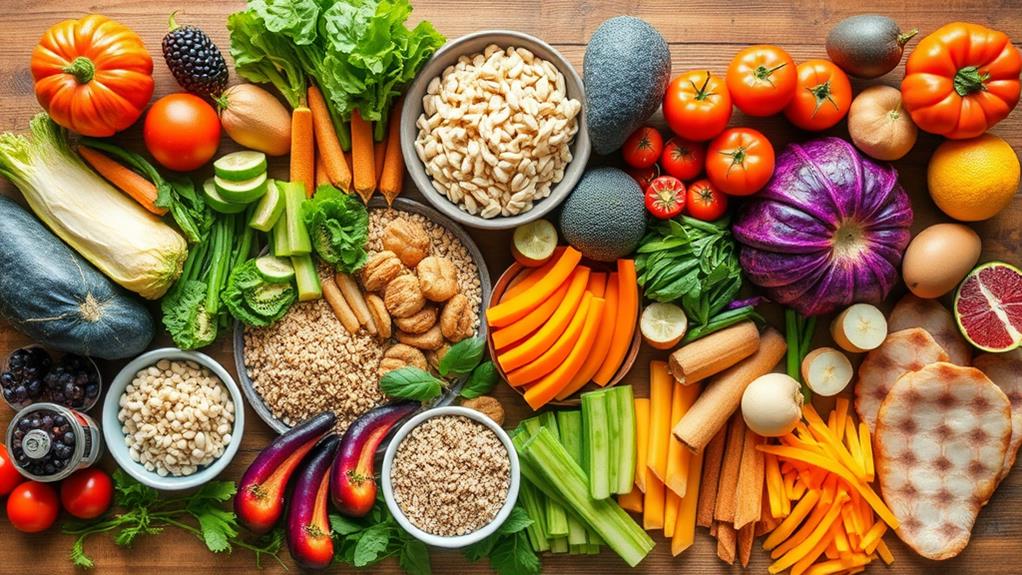
After concluding a ketogenic diet, it's essential to thoughtfully select foods that will support a smooth and healthy change to a balanced diet.
Begin by incorporating post keto snacks and healthy alternatives to ease the transition. Whole grains, legumes, and starchy vegetables are excellent choices. These foods provide the necessary fiber and nutrients that were often restricted during keto.
Healthy fruits like strawberries, kiwi, and baby carrots can be gradually added for natural sweetness and important vitamins. For example, one cup of strawberries has 11.7 grams of carbs, making it a sweet yet balanced addition. Kiwi and baby carrots offer similar benefits with 10.5 grams and 7 grams of carbs, respectively.
For those looking to include more plant-based proteins, black bean soup and edamame are great options. Half a cup of black bean soup provides 10 grams of carbs, while a cup of edamame offers 13.8 grams.
However, steer clear of high-sugar processed foods such as sugary desserts and breakfast cereals, which can lead to weight regain and disrupt your change.
Instead, focus on whole foods like nuts, seeds, and unprocessed vegetables to stabilize blood sugar levels and maintain a balanced nutritional profile.
Nutritional Planning Tips
To successfully shift from a keto diet to a balanced diet, one essential aspect is gradual nutritional planning. Evolving slowly helps your body adjust and reduces the risk of digestive discomfort. Start by increasing your carbohydrate intake by about 10 grams per day, focusing on healthy sources like whole grains and legumes. This gradual approach guarantees a smoother evolution and maintains your digestive health.
Incorporating nutrient-dense foods into your meals is crucial. Lean proteins, healthy fats, and high-fiber vegetables should be the cornerstone of your meal prep. These foods not only support overall health but also help keep you full and satisfied.
Here are some tips to reflect on:
- Increase carbs gradually: Add about 10 grams of carbs from whole grains or legumes each day.
- Focus on nutrient-dense foods: Incorporate lean proteins, healthy fats, and high-fiber vegetables.
- Monitor caloric intake: Confirm you're not exceeding your daily energy needs to prevent weight regain.
- Consult a dietitian: Get a personalized plan that aligns with your goals and activity levels.
Additionally, don't forget about hydration strategies. Staying properly hydrated can help control cravings and support your metabolism, making your evolution smoother and more effective.
Avoiding Simple Carbohydrates

Simple carbohydrates can pose significant challenges during your shift from a keto diet to a balanced diet. These carbs, like table sugar and processed foods, cause rapid spikes in blood sugar levels. This can make you feel hungry and crave more food right after eating. To keep your energy stable and avoid unhealthy snacking, limit simple carbs to no more than 4 grams of added sugar per serving.
Swapping foods high in simple carbs, such as sugary desserts and breakfast cereals with added sugars, for simple carb alternatives is key. Instead, opt for complex carbs that provide sustained energy and essential nutrients. Think about whole grains, fruits, and vegetables. These not only keep you full longer but also pack a nutritional punch.
Another pitfall to watch out for is hidden sugar awareness. Many processed snacks and beverages sneak in extra sugars that can add lots of calories without you even noticing. This can derail your weight maintenance efforts post-keto.
Reading labels and being mindful of what's in your food can help you stay on track.
Importance of Whole Foods
In moving beyond simple carbohydrates, the next step is to prioritize whole foods, which offer a multitude of health benefits during your shift from a keto diet to a balanced regimen. Whole foods are packed with essential vitamins, minerals, and fiber that your body needs to function smoothly. Think of these as the hidden superheroes in your diet.
They help keep your blood sugar levels stable and make you feel full longer, which is super helpful when you're trying not to snack every five minutes.
Consider plant-based options and seasonal produce to maximize nutritional value and variety. These foods are usually lower in added sugars and unhealthy fats, making them a better choice than processed foods. Plus, they help reduce the risk of weight regain after keto. Eating whole foods can also help your digestion, easing any stomach issues that pop up when you start adding carbs back into your meals.
Here's why whole foods are essential:
- Nutrient Density: Packed with vitamins and minerals.
- Satiety: Keeps you fuller for longer.
- Blood Sugar Stability: Helps avoid sugar highs and crashes.
- Healthy Digestion: Eases gastrointestinal discomfort.
Incorporating Healthy Snacks
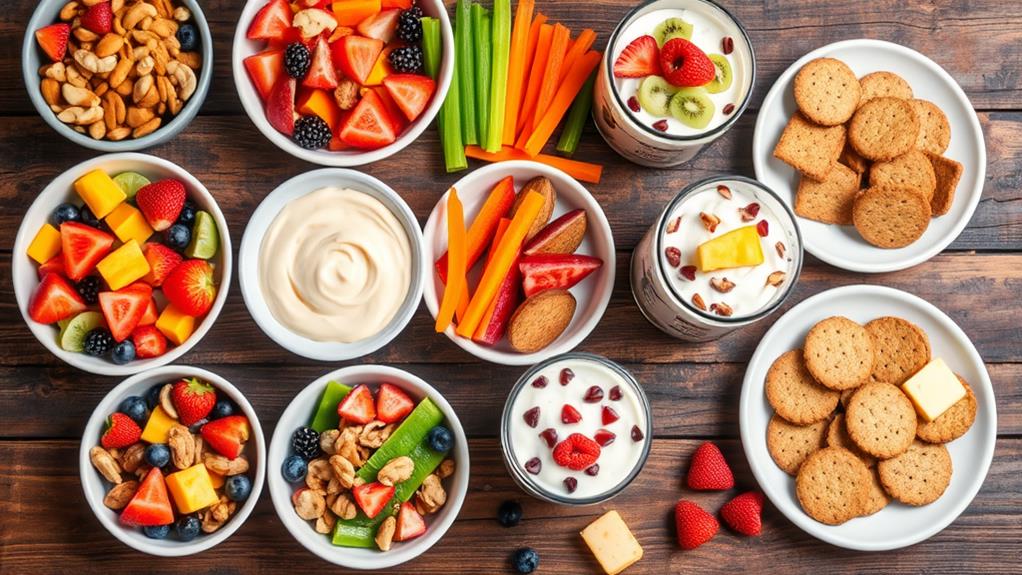
When moving from a keto diet to a balanced diet, incorporating healthy snacks is an essential strategy to maintain satiety and prevent overeating.
Nut snack ideas, such as almonds and walnuts, are perfect because they provide essential fats and proteins. These snacks can help keep you full between meals. For a bit of natural sweetness, fruit pairings like strawberries and kiwi are great choices. Strawberries have only 11.7 grams of carbs per cup, making them a tasty and low-carb option.
Unsweetened Greek yogurt is another excellent snack. It's rich in protein and can be enhanced with yogurt toppings like a sprinkle of cinnamon or a handful of berries.
Veggie dips, such as carrots or bell peppers paired with hummus, offer a satisfying crunch and contribute to your daily vegetable intake. Looking for chocolate alternatives? Dark chocolate with at least 70% cocoa can satisfy those sweet cravings and offers antioxidants.
Nut butter, like almond or peanut butter, can be spread on apple slices or whole grain crackers for a quick and nutritious snack. Energy bites made from oats, honey, and a bit of dark chocolate are also tasty and convenient.
Frequently Asked Questions
Can You Switch Between a Keto and Normal Diet?
Yes, switching between a keto and normal diet is feasible with proper planning. Emphasizing keto flexibility, individuals can accommodate diet variations by gradually reintroducing carbohydrates and monitoring body responses, ideally under the guidance of a registered dietitian.
How Do I Reverse My Diet After Keto?
To reverse your diet after keto, implement a gradual reintroduction of carbohydrates, focusing on complex carbs to mitigate keto cravings. Increase daily carb intake by 10g over 14 days, monitoring your body's response and maintaining hydration.
What Happens When You Switch off Keto?
Switching off keto can lead to keto cravings, digestive discomfort, and blood sugar fluctuations. Proper carb reintroduction is essential; gradually increasing intake over 14 days helps mitigate weight gain and allows the body to adapt smoothly.
How to Maintain Weight After Stopping Keto?
To maintain weight after stopping keto, guarantee caloric balance by tracking intake and engaging in portion control. Incorporate nutrient-dense foods, continue regular physical activity, and practice mindful eating to sustain the healthy habits developed during keto.
Conclusion
Shifting from the keto diet to a balanced diet involves reintroducing carbohydrates gradually, choosing complex carbs, and monitoring the body's responses. Emphasizing whole foods and healthy snacks while avoiding simple carbohydrates is vital. Nutritional planning helps guarantee a balanced intake of essential nutrients. This approach supports a sustainable, healthy lifestyle, maintaining benefits achieved during the keto phase and promoting long-term well-being.

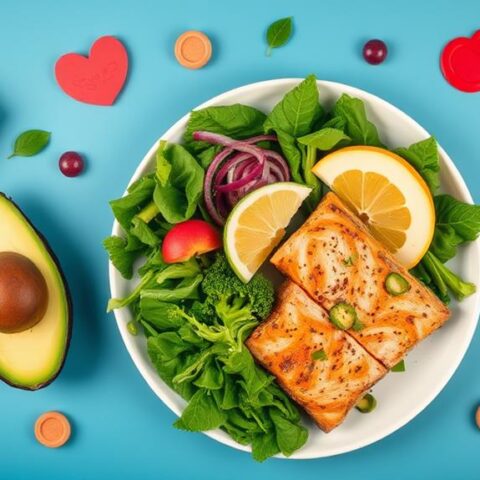
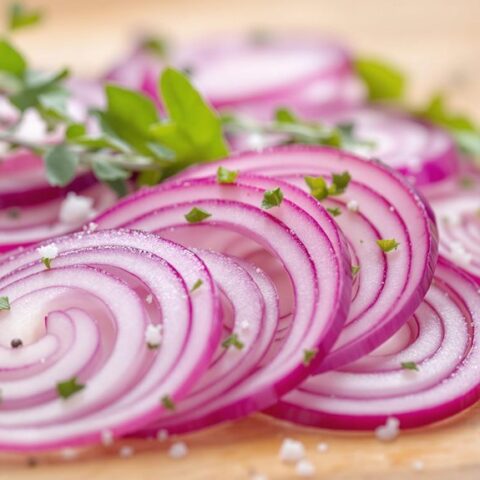





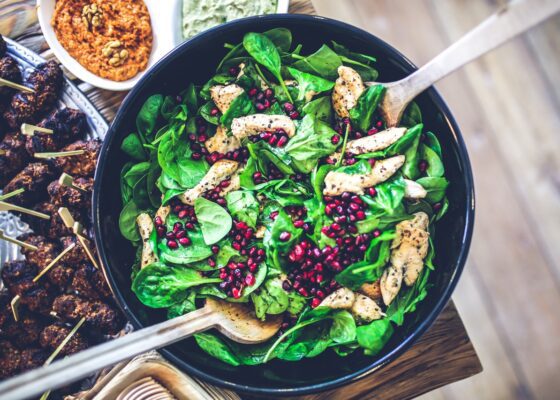

No Comments